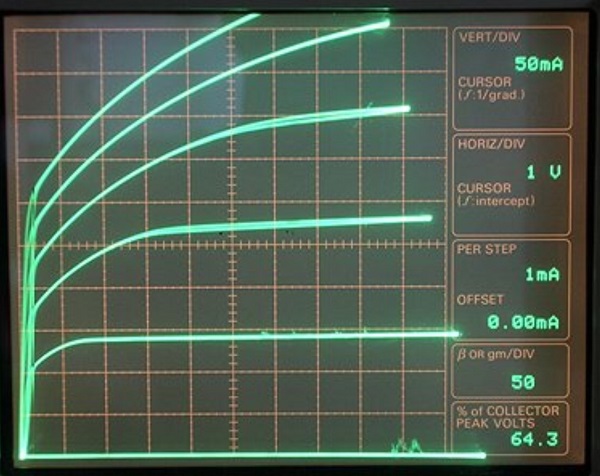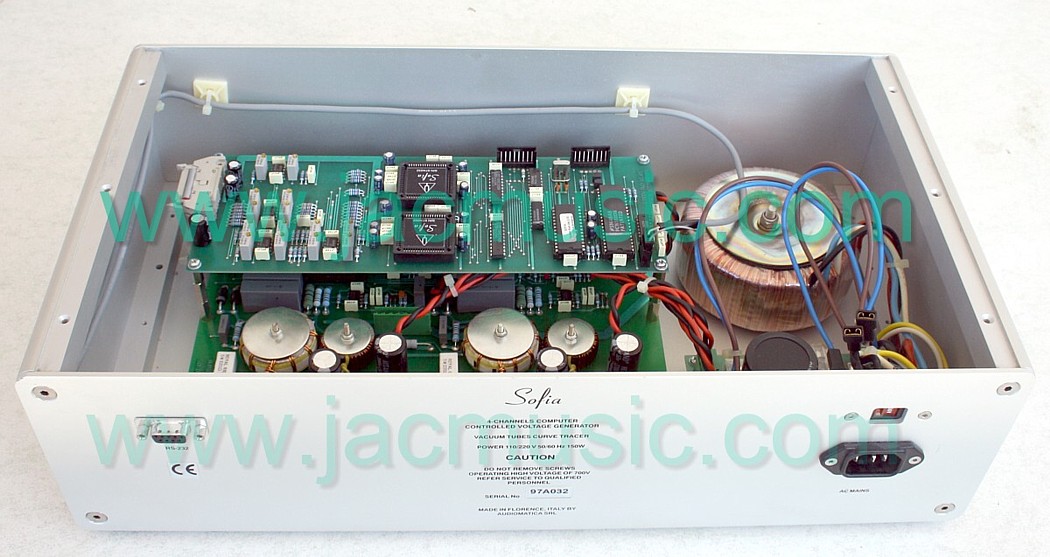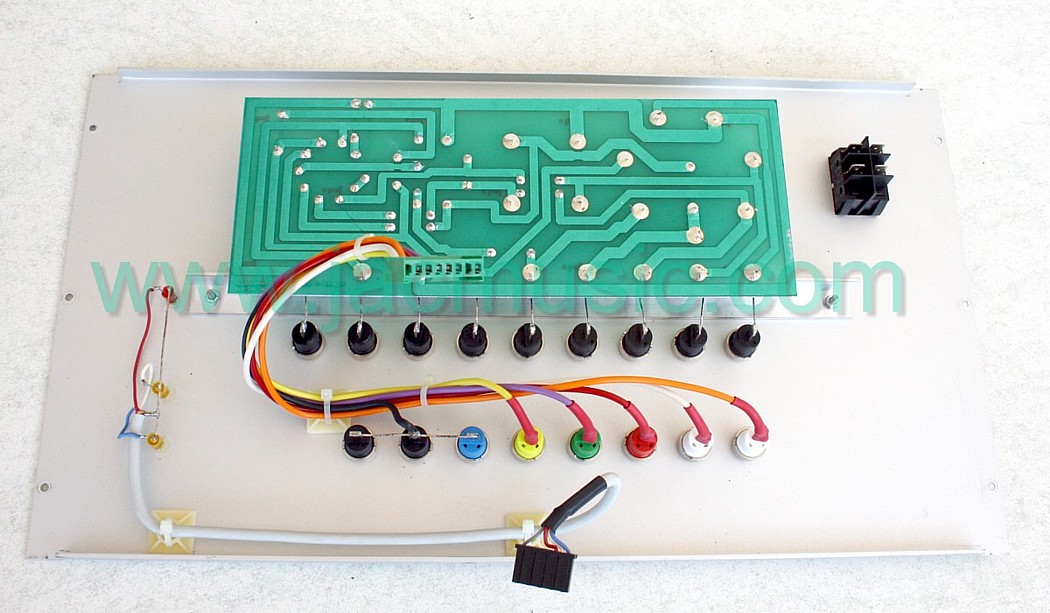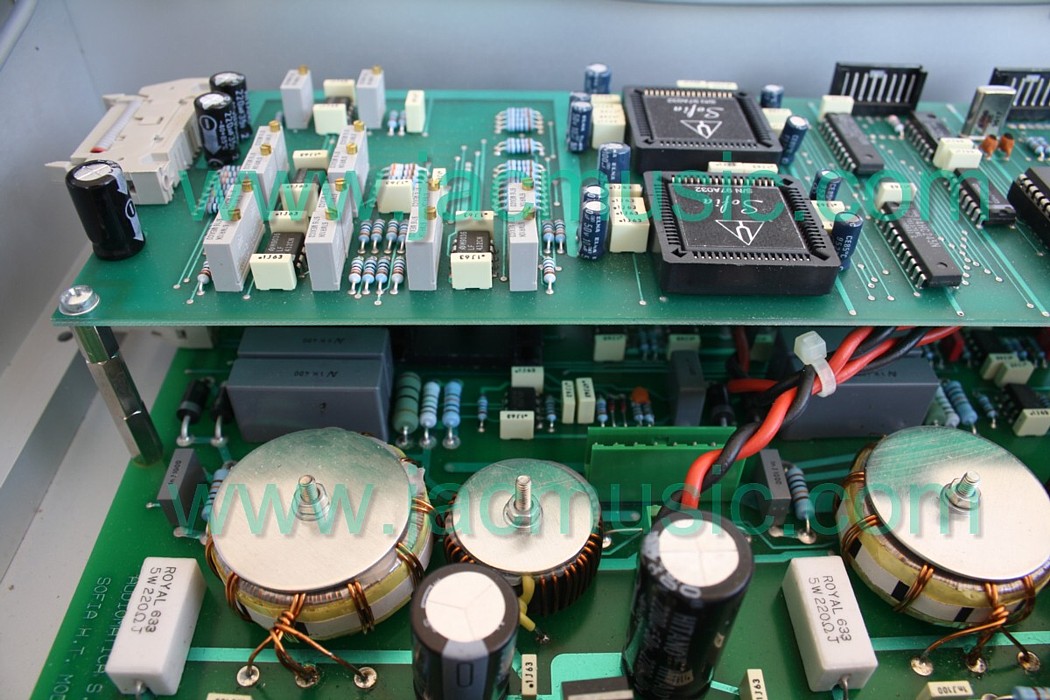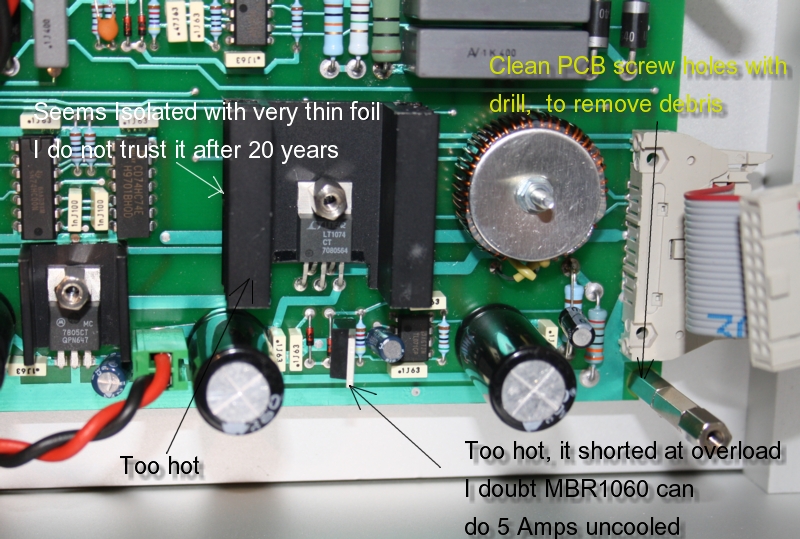Since 1993 Copyright Notice
The SOFIA Digital Tube tester
Made by Audiomatica Italy
Compare the SOFIA also with other digital tube testers
Specifications
Resolution: 16 bit
Plate voltage range: 0...700V
Plate current rage 0....250mA
Grid screen voltage range: 0...700V
Filament voltage range: 0...24V
Filament max. supply current: 5A
Grid voltage range: +10... -150v
History of the Sofia Tester.
This my favorite tester. When I use Amplitrex AT1000 (A comparable product) and I measure a dual triode with 2x 10 curves, together with an 10-Curves tube chart, it gets so boring I surf the internet while the AT1000 slowly finished its tests.
With the Sofia, there is no time for that. The curves are finished while you look at it, and that is test data and curves all together.
Unfortunately, the Sofia was commercially not a success, and production was stopped suddenly, even while they had their last order. (It was from me!) They just did not follow up on the order, saying sorry we stopped with it. Looking back now upon the years which came after this decision, I think they made a major mistake with that, financially. Some years later, tube tester business boomed , and the winner was Amplitrex, with a product for the same price, and full of software bugs.
I think Audiomatica was ahead of it's time with this product, and perhaps even that was the reason for the low sales. Many years later, I was informed, only 80 pcs were ever made. You need to see when this was. It was in the early 1990's PCs worked with MSDOS, and you had start programs with line commands. However once the programs run, they can be quite sophisticated. So was the SOFIA program, it feels like Windows, once started under DOS.
In those days, this tester was an overkill. I spoke about this with Audiomatica. They thought the buyer group would be the professional companies, the ones making money with matching. These companions either had to restore vintage testers, or build dedicated hardware of their own. The Audiomatica idea was, these professionals would be interested in something better. Much to their surprise, the so called "professionals" had ZERO Interest whatsoever. Those who build their own, got along with that, and the others seemed to be doing fine with their old units. Yes, I know this behavior of tube professionals myself. They "need" everything which is not for sale, and when it is for sale suddenly, they don't need it any more. Too bad, but Sofia was caught by this attitude.
Finally, the remaining buyers of the Sofia Tester, were private persons, the kind of rich old boys, looking for toys. However this group was a not preferred by Audiomatica, because they created too much issues.
Then came the day, when the software Gods at Microsoft made the decision easier for Audiomatica. As soon as the first real Windows (3.1) appeared, the virus mania began. There was no internet in those days, but attacks were via the Serial RS232 port. So Microsoft added a in Windows 3.1 a software layer between the RS232 port and the PC, to block the virus. However that software layer caused big troubles, as the RS232 port was not real time any more. Due to this layer, it was impossible to use the Sofia DOS program under Windows 3.1. Most other programs worked fine, just not those which get problems with the delay. So the Sofia program could only run in real DOS, and not in DOS under windows.
Mr. Maurizio Jacchia, President of Audiomatica told me the following by phone: They had an preliminary Windows version working, but sales was too low to invest the massive amount of time needed to finish it. Suddenly they cancelled my pending. Well this was in 1995, and I found a good used one, and another one with small problems, which I can save as a parts donor.
I keep on saying, it was a big mistake to obsolete this tester. I may have to do with some attitude of Audiomatica. When you see today, how many Amplitrex are sold, and believe me, Amplitrex is not half as good, then you can see, Audiomatica was so much ahead of it's time. I think it would have been much better for them. to bite through the sour apple of migration from DOS to Windows. If so, they basically would have had the sales that Amplitrex has now, or perhaps even more. Which I estimate at least 150 pcs per year. Being really so much better, the Sofia could have sold at 300 pcs per year. At a price of 3000 Euro, that is 900.000 Euro per year.
Amplitrex is doing so since 30 years also. 150pcs per year for 3000 Euro, that is 13.5 Million in total. Not bad.
The best of the Sofia, it is intuitive and fast to operate. This is such a masterpiece of software design. Combining the fabulous speed of DOS software, with 16bits A/D converters, this tester is a pleasure to use, even after now 30 years of service, nothing can beat it's speed and comfort. It doesn't have this (much!) too loud fan of the AT1000. It does not even have a fan at all. It boots within 1/3 of a second. It plots a complete curve chart 20x faster. Doing so at much higher graphical and electrical resolution. With the AT1000 when you draw a 10 steps curve chart with high resolution, I can start surfing the internet until it is finished, and then it doesn't even have the normal tube test, that would be additional, you need to wait once more. Or twice for a dual Triode.
With the Sofia you press "start", the blue Hazard LED switches on (Which AT1000 doesn't even have), the RS232 LEDs flashes, and 15 seconds later, the Hazard LED goes off, and it's all completely done. That is fun to do. So curves and dynamic test results come up in one screen. Using the AT1000 is boring compared to this. I enjoy using the Sofia every time, but there is nothing pleasant about working with the AT1000.
The things this software can do makes you silent for a wile, and then you say... wow! So I say today, those who write tube tester software, and not look at this classic software first, it's like re invent the wheel, and not make it round. Oh, and yes it can be downloaded for free, with all the demo things and stuff with it, and it works on any DOS capable Windows PC. The only thing which does not work under Windows, is to connect the real hardware. But the demo version does not need the hardware. You can start it up without hardware connected, and load the demo files.
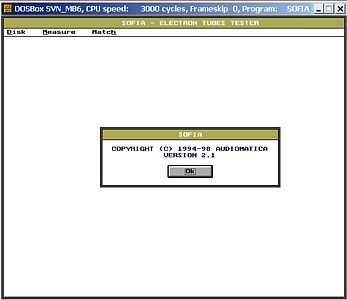
1... Start the program. It takes 1/3 second only!
2... Select a tube. This is 1994 DOS, with mouse control and menus. In the looks of windows 3.1
3... Make the socket connections You need to plug the cables as it says here.
4... Start test, and wait 15 seconds. Curves + Test data appear all together
The screen 4) is full of information and all soft keys work and do something. What you need to do, is boot your computer first. However, since you need to boot only the BIOS, and no need to start Windows, you are ready quite fast, even though the PC is an older DOS one. So then when you enter in DOS the run code for program which is "Sofia21", the screen nr1 pops up almost without delay. Then click your choice, like: Matching of already tested tubes, Quality Control, Edit tube data, etc, or as here in this case: "Measure" (which is tube testing). So then the screen 2) pops up and there you go. Select a tube from the database, and screen 3) tells you what cables to plug. (This plug action is not needed with the Amplitrex, BUT... for that the Sofia can do any connection, whereas Amplitrex is limited, and you fill find several tubes it can't connect, and you need adapters).
To end DOS, you just switch off the mains of your PC. Much better than Windows! The next time it still boots just normal.
When you want to test and match a series of -say- 100 tubes, the high speed and natural comfort of the Sofia software, makes it the undisputed king with great distance to modern products. These all seem to have snail speed software, compared to the SOFIA. Moreover, you can save the curves, and let the Sofia do the matching now, or at any later time. So it tells you for instance: Pair#1 is Tube 4+12, Pair#2 is tube 17+49, etc. So it comes up with 50 pairs, and even sorts them by matching quality. The matching is not just done, by sorting the plate current in a table. No sir! It does so by overlaying the curves best possible way, using a mathematical approach, which is very similar to the way the RMS result of a wave shape is calculated. It works indeed with a Root Mean Square method, showing the designers of this software knew their math. Isn't that a good idea, the software designer knew his math. With all respect to the Amplitrex, I don't get the feeling with this product. If I want to do this with the Amplitrex (overlay the curves) I print them, put several sheets on each other and hold them against the light. I can do so with maximum four sheets of paper and with more sheets you can't see any more what your are doing. In the computer age, I feel a bit silly, because matching is what I use the AT1000 for most for. This 30 years old Sofia does this job in just seconds. This tester, surprises me with nice features, even today, in 2024. s I re edit this text. For me, the SOFIA is like a relict from the good old days of user friendly software engineering. It reminds me of the older Hewlett Packard instruments, that also work so user friendly. Unlike the AT1000, the Sofia NEVER crashes the software. No annoying "run time error" which the Amplitrex is so good at. WIth Sofia, when you do something wrong, you can correct it, and there is never a crash.
The hardware is beautiful made. This was an expensive very high quality case.
About shorts and fuses (skip this when not interested).
First let me start with the Shorts risk with a Sofia, because you always have to keep this in mind when using it. When you forget about the "shorts tests" with any historical tube tester you make a beginners mistake because these testers will be seriously damaged by a shorted tube. With computer controlled testers, you have little influence on this. The Sofia does have an overload test, and a heater circuit test, but that is all. It is not enough. I cannot say it is fully unprotected, and indeed it switched off when I made an error with the cabling (tube connections). Yet, the previous owner warned me, the tester needed a few times a repair, after testing hundreds of SOVTEK KT88, and some shorted ones were amongst those. Since he used the tested for KT88 high quantity testing mainly, he gave up on the Sofia. He had it repaired once more, and then sold it to me in a factory repaired condition. Now I don't know what he has been doing, but from my experience with people, tubes and equipment, I learned that so called "professionals" (and companies) make serious mistakes as well. Well still I regard it a strong warning he gave me, and I will not put any questionable tubes on the Sofia, and not use it as a work horse. Only use it only for tubes that are basically good, but I need the curves from. When I have time, I will put a protection series lamp in the grid circuit, same as Hickok uses it, and I have seen that on other testers too. The other power supply outputs I will protect with normal fuses and put reverse diodes over it. That seems all missing. The most common short is cathode to heater with KT88. Since the cathode is grounded in the Sofia, that will short circuit the heater, so the fuse hopefully helps here. Another common short is grid to cathode, and most likely the a series lamp will cover this very good, since a low current lamp is known to be the fastest fuse there is. From my R&D days I remember an extremely useful method to protect high voltage motor control circuitry. You use a fast power thyristor, which shorts the DC voltage directly after the capacitor of the rectifier circuit, and in the path is a normal fuse. Very crude, but the most useful method I have ever seen, and low cost too. When you fire this thyristor, you switch off the High Voltage to all electronics with a delay of less than a micro second. Then, some 10 milliseconds later the fuse will blow. Interesting, the thyristor survives this. Even if you blow the thyristor, the damage is a short circuit, so it still does it's function, and all you need to do is replace it. For firing the thyristor you can use any detection circuit you define yourself. Such as a current overload detector of the heater supply in this case. Well... these are just ideas. I will first put a fast fuse inside.
I once had a FACTORY NEW Electro Harmonix 6922 tube with a hair-thin wire wrapped around all pins, in a circle! So all pins were short circuited. Don't ask me what that was, but it came out of a box with 100 factory new tubes, from Russia. Also I have still here in my memorabilia cabinet a new Electro Harmonix 6SN7, also from a 100 pcs factory box, with the socket one position rotated, so that tube can never have worked. I do not try to prove here, they do lousy testing at EHX. These were tested with the Russian L3-3, and it survived those, though the 9-pins all together shorted 6922 made some smoke come from the inside. Well it survived that. Actually the Sofia would have spotted this mistake too, because it will not switch on the High Voltage, after the tube passes the heater current test. Heater current is measured, and must reach it's correct value before the rest of test program can start.
Another possibility is, a tube that appears good at 250V will short circuit at 500 Volts. This can happen if the tube is gassy. This I already had, and the tester switched off normally and detected the error.
The rest of the story.
The software
Though DOS is faster and it never stalls, it was a pain to install it. But ok I have it done, and spend the Sofia it's own DOS computer. This is a Hewlett Packard Kayak 800 workstation from the year 2000, with a factory build in dual boot option for DOS and W2000. If you know how to do that, you can install a dual boot. DOS + Windows, on most older PCs, probably XP and W7, but what I like about the Kayak 800 is, that it is factory installed like that, with recovery DVD along with it.
The Kayal used to be available on Ebay, but they were never really cheap. It's one of the finest real DOS machines. I have not tried it, but I expect it can run Windows7 because it has 1Gb of RAM. Though the W2000 works still fine, it hooks up in the network still, it has USB, and I have noticed, W2000 doesn't get slower when it gets older. Something you can not say about XP, and sure not about W7, which suffers from aging. Also, W2000 is FAST. Much faster than Windows 11. So I stick with W2000 for my test computer. After the tests are done in DOS, I can re-boot in W2000 and copy the results on a USB stick and take it to a modern PC. From there I open the results again with a DOSBOX virtual machine. The regular virtual machines, they all don't work. The good thing is, once you have the Sofia software working, it is the best piece of test software I have ever seen. Even under DOS, the speed beats anything, and Graphics quality is good. If you have an XP machine, the Sofia software runs fine, but it can be used only for looking at test result files (the .pte files). I use this option a lot, because once you have a .pte file, you can plot the curves on your screen once again, and move the cursor all around to analyze the curves, and get gain, transconductance and Rp at a random point. Also matching can be done afterwards, or repeated with a few of the tubes removed from the list. Still for actually measuring, you need DOS always.
What is good about the Sofia, and seldom mentioned, is the fabulous matching software. If software developers read this, you must spend some time on it. You can save up to 200 curves, and the program calculates which curves fit best to each other, using a mathematical error function. The Sofia does this in 10 seconds for 200 curves. That's DOS :). So we have to say it, the software is GREAT and the best part of it, and in REALLY compensates the trouble using DOS. Furthermore, graphic capabilities of modern LCD monitors seems the perfect thing for this software. I don't know how this works, but it looks if the pixels from the DOS Program fit exactly 1:1 on the pixels of the LCD monitor. The result at the end of this page do not show this to you, because higher Windows versions blur the sharpness in pictures. But in DOS they are crystal clear.
One mystery remains.... At the power supply main board is a large connector, unused. It is of the same kind as the top board. So one connector connects the power supply to the microcomputer board, another (similar) one is empty and unused. Who knows what is was intended for! If I was to say, I would connect a relay board to it, so the cables at thee deck get obsolete, but that is really only just a guess.
It has no tube data base inside, though that could have been added to the DOS program. They added only 10 tubes to give you an idea how to do it yourself. However, new tubes can be saved under DOS, and after a while you have most tubes you need.
Software Bugs
![]() Look at the Chinese letter for bug. It looks like a bug, and it is pronounced as "zzssh". Same as the Russian letter Ж which looks like a bug too and is pronounced "zzssh" as well.
Look at the Chinese letter for bug. It looks like a bug, and it is pronounced as "zzssh". Same as the Russian letter Ж which looks like a bug too and is pronounced "zzssh" as well.
I found only two bugs with the Sofia.
- The heater voltage is connected with one end to ground, and the other end is heated with DC. For indirectly heated tubes that is no problem, but this gives an issue when testing directly heated tubes (DHT). The reason for this is, with DHT, the cathode's electrical reference is by definition the middle of the filament. So you lift up the cathode reference point by by half of the heater voltage. Not much of an issue when the heater is +2.5V and the grid -45V, and low gain tube such as a 2A3. The error is 1.25Volt only and you would not even notice at this low gain of 4x. However, it is a major issue with a tubes like RE134 or the Emission Labs 30A.
- There is a year 2000 bug. That is pretty stupid for a software from 1995.
The hardware
This is made in non-SMD. You will appreciate that when you have a repair. There are very few connectors, which devices are always a long term problem in old electronics. The electronics don't get hot, and it needs to cooler fan. The fact the electronics stay cool, it the ticket for a long life. The printing on the IC's has not been removed, and these are all standard parts, that still can be bought. The circuit boards are clean and tidy, and doing service and repairs is not hard to do. The A/D converters part has many potentiometers, but probably most are just for the offset of the Op amps, and when needed I can dig into this. So far this is not needed, and I won't touch it. The core of the A/D and D/A converters are ICs used for sound cards originally, these work very well, and can still be found on Ebay. So are all other parts. The microprocessor is a first generation 8 bit working at y 6mHz. Given it has only 1400 Byte of code to take care of, this speed is more than enough. I expect the tester itself has a start up routine in the firmware, and after that reports itself via the RS232 ports as ready to go. It takes only commands to set the voltages, and responds with plate current, screen current and heater current. All higher functions are managed by the DOS software, which is not run inside the tester but on the PC.
The PC port is RS232, and here comes a bit of a problem setting up modern PC's for an RS232 port. Though I was able to use a USB to RS232 cable under Windows7, the accuracy under a non-windows DOS version and a real RS232 port is better. For the rest of the DOS story, read the software part.
The case is beautiful quality, larger and heavier as you might expect.
Very useful, and simply forgotten on many other testers is the High Voltage "HAZARD" lamp, indicating the high voltages are switched on. (I passed on this idea to Ronald Dekkers, the maker of the uTrace. He has already included it for newer versions).
A major shortcoming of the SOFIA, is the tube connections have to be made by plugging in the cables. Well some protection comes from this too, since you cannot plug in two cables in one hole, so an error you usually see, but this stays kind of touchy. Best is to make colored overlay cards for the tubes you want to test. That works faster, and is error-proof. An advantage we have here too, since these are all banana connectors, and you can access the tube connections easily for whatever purpose you need it. Like connect external meters to it. Even put in a current link.
The deck panel is removable easy and quickly, and you can add more tube sockets to it.
The specifications
Now looking at the specifications this makes you amaze. This speaks for itself. It can even test 6C33 which is usually a problem with other testers because of the heater power. Also you can make curves of the 845 and 211 up to 700V. Not extremely much for this tube, but you come in a meaningful area of the curves. Even a GM70 with it's 20Volt, 3Amp heater is possible.
Technical Article about the Sofia
Known problems: Very few, but some are SERIOUS. .
All I found was a year 2k problem with the date settings. So the year becomes 115 in 2015. Instead of 15. Pretty stupid for software from 1995, but ok bugs are always stupid. A work around to set my PC to 1915 doesn't work as DOS refuses that as invalid date. |
| BIG RISK: All chokes and ring core transformers have un isolated windings, which are mounted directly on the PCB, directly on some tracks. Also for the two 750 Volts transformers. There is no isolation underneath, so all you have is the green paint of the PCB, and the isolation of the transformer coil wire. Definitely a mistake, and a big risk at 750V. You should put an isolator underneath there immediately. I used a mica plate. |
KNOWN TO CAUSE DEFECTS: I know from other users, and from myself, the LT1074 regulator shorts sometimes. This is a very easy repair, and you can still buy them on Ebay. Reason for this is several. 1) the cooling plates are isolated from the PCB with.... transparent office tape, with the PCB tracks underneath (!). Yes, believe me, it was just office tape. Now, that was a silly thing to do. Combined with the heat, that shorts the PCB tracks underneath of course. So I took the power supply apart and added mica underneath all coils, transformers and cooler plates. 2) The LT1074 is not sufficiently cooled. When testing a 5A heater tube, it gets so hot you burn your fingers on it. 3) Next is the flyback diode used for the LT1074. This is not cooled at all, but if you pull 5A from the power supply, the flyback diode is loaded with 5A too. It gets far to hot, and it shorted with my Sofia. When this diode shorts, the LT1074 gets in short circuit protection mode, but it's not a good thing for the LT1074. Put better coolers on those, and use mica for isolation, not office tape.
|
| Some of the screw holes (See above pictures) are full of metal debris particles inside, better remove these, because this is a High Voltage power supply. |
The main rectifier is mounted badly. There is no mounting screw, and thermal contact is bad. It cost me 5 cents and 20 minutes to fix this. |
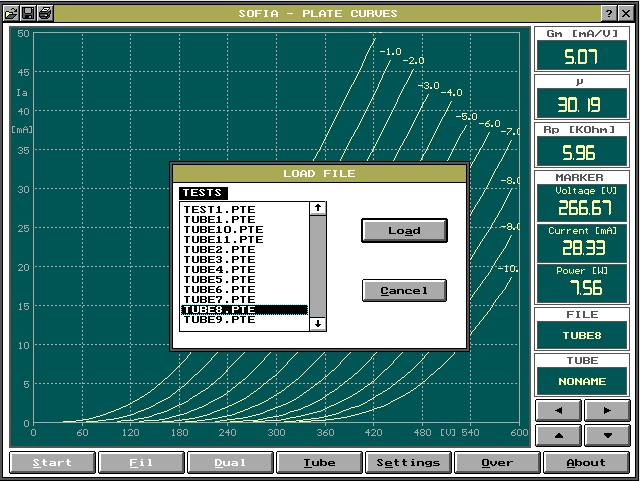
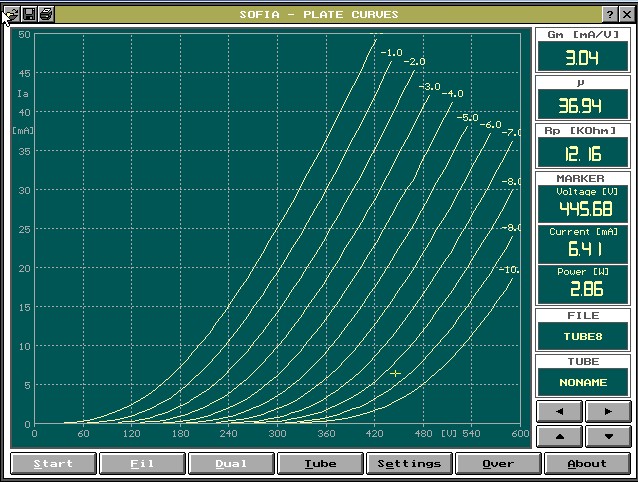
It does not need much fantasy to understand what product must have inspired the makers of the Sofia. Here is a picture of the Tektronix 370A
